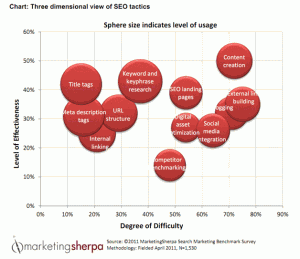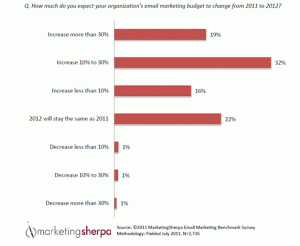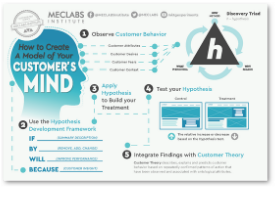One thing I really enjoyed at Email Summit 2012 was being able to walk around and talk to the email marketers of the world about the tactics they’re using. For example, I learned about marketers’ experiences with sales and marketing automation for small businesses over breakfast and European privacy regulations over lunch.
If you weren’t able to attend (and even if you were), I hope this blog post can serve as a proxy for that experience. During some of the general and breakout sessions at Email Summit 2012, we conducted a live poll using Acxiom technology where attendees could text to vote. (Full Disclosure: Acxiom was an Email Summit 2012 sponsor.)
In this blog post, I’ll share some of these results, along with some resources to help you act on these tactics.
Please keep in mind that I don’t intend this data to be regarded as statistically valid, rather view it the way you would anecdotal information you would attain from networking.
There are many validity threats, including the fact that the sample we surveyed (Email Summit attendees) is likely a skewed sample and much more active and experienced than the average email marketer since they invested the time and money in attending Email Summit. So the average email marketer is even less likely to be using these tactics.
That said, let’s jump right in …
How are you deploying mobile in your marketing strategies for 2012?
In research conducted for the MarketingSherpa 2012 Email Marketing Benchmark Report, mobile was identified as the most challenging channel to integrate with email.
So it’s not surprising that only a handful of email marketers considered themselves advanced at deploying mobile in their marketing strategies.

- Advanced (3 respondents, 7.31% of all respondents): We currently deploy advanced tactics to reach our mobile audience (e.g., geo targeting, mobile apps, SMS outreach, email optimized for mobile)
- Basic (16, 39%): We have optimized our website (or) our emails for mobile
- Considering (19, 46.3%): We are considering mobile marketing, but have not yet decided upon a strategy
- Unconvinced (3, 7.31%): We do not believe that mobile marketing is the right fit for our audience
Some resources to help you with mobile marketing:
Have you used SMS and/or QR codes for email list sign-up?
We asked this during a session I moderated with Ryan Amirault, Digital Marketing Manager, Whole Foods Market.
[whole foods]
Ryan’s team saw some impressive results — generating more than 2,000 email subscribers from SMS and QR codes. Ryan’s advice:
- Place QR and SMS in strategic locations. For Whole Foods, that meant table tents, meat/deli/seafood scales, bathroom stalls, registers, cafés, grocery aisles, eating areas and guest services
- Test QR codes before deploying creative materials
However, 67% of Email Summit attendees have not tried this tactic at all.

Here are a few resources to help get you started:
How are you designing your emails to fit into your mobile marketing strategies for 2012?
There was limited response to this question, which is not surprising considering that we learned in the first survey that a minority of marketers are really engaged in mobile tactics.

- Relevant (7 respondents, 15.5% of all respondents) – We deploy emails targeted for relevance in the mobile environment (e.g., geo-targeting)
- Responsive (6, 13.3%) – We have designed our emails to be responsive for a handful of mobile operating systems (e.g., iOS 5)
- Visible (14, 31.3%) – We have added a “view on mobile device” link at the top of our emails
- Considering (18, 40%) – We are considering integrating email with mobile marketing, but have not yet decided upon a strategy
Here are a few resources to help you with your mobile email design:
Do you optimize email landing pages for specific devices?
Let’s get a little more granular, and instead of talking about mobile as a big picture, look at how marketers handle devices …

- Yes, iOS – 5 respondents, 6.17% of all respondents
- Yes, Android – 1, 1.23%
- Yes, multiple devices – 23, 28.3%
- No – 48, 64.1%
If you’re thinking about getting device specific, here’s some help:
With regard to email testing, which of the following best represents your organization’s efforts?
While mobile clearly is a hot topic for marketers, let’s look at a more tried and true tactic – email testing.

- Basic testing (14 respondents, 21.4% of respondents) – Subject lines, personalization, copy
- Average testing (11, 37.2%) – Templates, timing, automation
- Advanced testing (4, 17.3%) – Validated tests, multi-varied options
- Expert testing (2, 23.9%) – All aspects have been tested and optimized
Some inspiration and ideas to get you started testing or give you new ideas for future tests:
What do you think will have the biggest impact on email marketing in 2013?
At the MarketingSherpa Email Summit, we focus on what really works. However, sometimes you have to look past what is already proven, gaze into the crystal ball, and try to make strategic decisions today to position your company for the opportunities (and threats) of tomorrow.
So what will tomorrow bring? Let’s take one extra spin on the email marketing carousel of progress and take a look at what your peers think will have the biggest impact on email marketing in the near future.

- In-line Video (15 respondents, 10.7% of respondents)
- Social Data/Content Integration (48, 34.2%)
- Privacy Legislation (29, 20.7%)
- Dynamic Content (48, 34.2%)
As you try to peer over the hill for your own marketing efforts, here are a few resources that may help:












 The landing tab for the
The landing tab for the 




